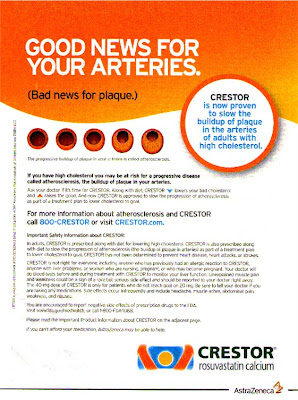Have you seen this new Crestor print ad from AstraZeneca? Crestor is one of the newer anti-cholesterol drugs that recently gained the right from FDA to claim it slows the progression of atherosclerosis (plaque buildup in arteries). That new indication is clearly the focus of these ads, a sample of which — taken from the February 4, 2008, issue of Time Magazine — is shown above.
Recall that with all the hullabaloo over Vytorin/Zetia and the failure of the ENHANCE clinical trial (see “Should I Stop Taking Zetia?“), Merck and Schering-Plough have pulled direct-to-consumer (DTC) ads for these products from TV. I haven’t seen any Crestor ads on TV lately either.
As I suggested previously, I believe these ads will be back on TV after Merck/Schering figure out how to spin the benefits of Vytorin/Zetia in light of the failure to demonstrate any effect on plaque. Clearly. they will have to make a case that LDL cholesterol is the leading cause of plaque buildup in arteries even though this wasn’t proven by the ENHANCE study.
But NEW Crestor TV ads — like the print ads — will be able to bypass the cholesterol-lowering message, which consumers now suspect is the lesser benefit compared to lessening plaque buildup (see “Cholesterol Drug Users Discuss Their Medication“).
The basis of Crestor’s FDA-approved claim that it “slows” plaque buildup is data from 876 patients in the “METEOR” — Measuring Effects on Intima Thickness: An Evaluation Of Rosuvastatin 40 mg — study (see excerpt for the Crestor PI below).
The interesting difference between this study and the Vytorin Enhance study is that it compares Crestor to NOTHING (placebo) whereas the ENHANCE study compared Vytorin to simvastatin, the generic version of Zocor, which is the non-Zetia component of Vytorin.
See, folks, this is why the drug industry doesn’t like to do “head-to-head” clinical trials that some critics say need to be done to justify the extra expense of newer drugs compared to older ones.
Note the Irony
The ENHANCE and METEOR studies are similar in one respect: each studied only a few hundred people over a limited time period. Merck and Schering-Plough are trying to say we shouldn’t place too much emphasis on a clinical trial involving only a few hundred people. Yet, a clinical trial involving only a few hundred people was good enough for the FDA to approve a new Crestor indication worth hundred of millions of dollars to AstraZeneca!
The take-away message from the METEOR study is this: 52.1 % of the Crestor-treated patients in the study demonstrated an “absence of disease progression,” compared to 37.7% of patients in the placebo group. That’s a net difference of 14.4%. So, of the 876 patients studied, 126 more were helped by Crestor than by placebo. Or, to use the number needed to treat (or NNT) statistic (see “The Statin Lottery: Number Needed to Treat Statistic“), for one person to benefit from Crestor, about 7 people have to be treated (NNT=6.95). Still, we’re only talking about “absence” of progression of plaque buildup, not prevention of heart attacks, which is the ultimate endpoint.











![6 Digital Tools at the Center of Healthcare Digitalization [INFOGRAPHIC]](http://ec2-54-175-84-28.compute-1.amazonaws.com/pharma-mkting.com/wp-content/uploads/2021/04/6DigitalTools_600px-100x70.jpg)




